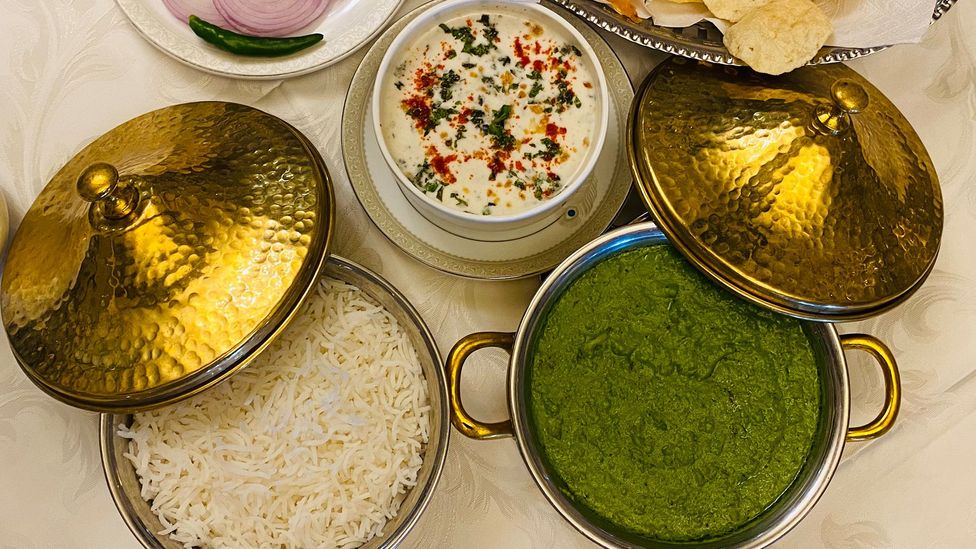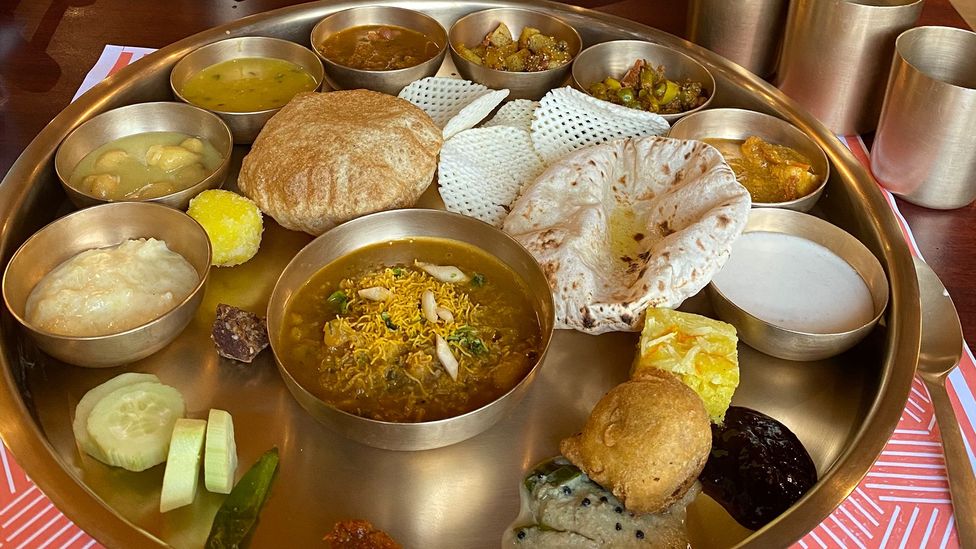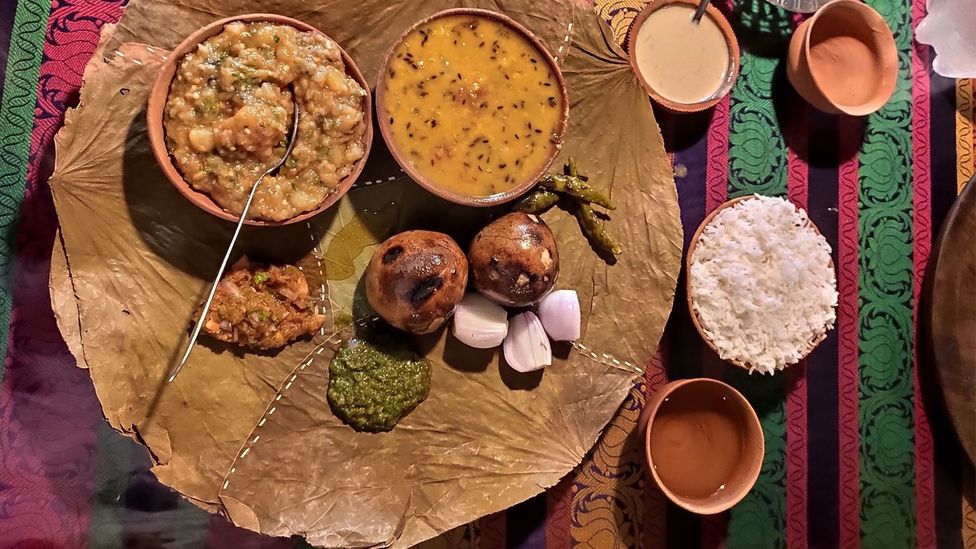Inside the luxury hotel BrijRama Palace, an imposing sandstone structure on the Ganges at Munshi Ghat, executive chef Manoj Verma applies his encyclopaedic knowledge of traditional textbook vegetarian Varanasi cooking. "When I first took over the kitchen, I immediately included dishes like khatta meetha kaddu (sweet and sour pumpkin) and nimona (spiced mashed peas) on our menu," Verma said. "These are humble dishes that our guests would have never had the opportunity to taste otherwise," he added.
Verma demonstrated how he prepares nimona, reducing a green pea purée in a pan, adding boiled potatoes and pouring over a mixture of fragrant spices such as whole cumin seeds, asafoetida and green chillies tempered in hot oil. Served with a dollop of ghee over steamed basmati rice, the creamy sweetness of the peas and the contrasting bite from the potatoes is essentially Varanasi's answer to Italy's cucina povera, in which local "peasant" foods are being elevated by innovative chefs.

Chef Manoj Verma’s nimona is served with rice and raita at BrijRama Palace (Credit: Amrita Sarkar)
Verma indicated that the 2019 meat ban has fostered creativity among a new generation of chefs in Varanasi. Although he had fed his share of celebrity Indian and international guests, his greatest honour came when chef Khanna came to taste his food. In what is considered to be the ultimate mark of respect in Indian culture, the Michelin-starred chef bent down and touched Verma's feet. "It was in the midst of other diners at my restaurant. I will never forget it, " Verma said.
Across town, Shree Shivay is one of a growing number of restaurants serving local sattvic recipes. Today, locals estimate are anywhere from 40 to 200 sattvic restaurants in Varanasi, a huge jump since the 2019 meat ban. The restaurant's menu, which changes twice a day based on what is available at the local market that morning, features thalis, or set offerings, with at least 12 different dishes. After months of careful experimentation, the restaurant's three chefs came up with a formula where they could mimic the taste of any sauce or gravy using five key ingredients: cashews, poppy seeds, melon seeds, tomatoes and chironji (a nutty seed endemic to northern India).
My thalifeatured items like kadhi pakora (fried chickpea flour dumplings in yoghurt sauce), rajma (red kidney beans in tomato gravy) and paneer (Indian cottage cheese). The flavour of roasted chickpea flour in the kadhi, the viscosity of the rajmasauce and the freshness of the paneer were unlike anything I had experienced across northern India.
Beyond its restaurants, Varanasi's street food scene is as vibrant and electric as that of Bangkok or Istanbul but enjoys none of the media hype. Although many of the sattvic foods sold are unique or inventive variations of snacks found elsewhere in India, they do not benefit from the hype of Delhi's chaat (savoury snack combining several textures and flavours) or Mumbai's vada pav (potato burger).

Shree Shivay is one of a growing number of Varanasi restaurants serving local sattvic dishes (Credit: Amrita Sarkar)
One such example is the tomato chaat, sold at the Kashi Chaat Bhandar stall. "When the daughter of billionaire industrialist Lakshmi Mittal got married in France, they chose us as one of the caterers," said third-generation owner Yash Khetri. Made with a tangy and spicy base of mashed tomatoes bathed in a cumin-spiked sugar syrup and topped with crunchy sev (deep-fried chickpea flour noodles), the original recipe was developed in 1968 by Khetri's grandfather. Today, you won't find it anywhere else outside of Varanasi.
Another example is the frothy sweetened milk tea served at the Lakshmi Chai Wale stall in terracotta cups with a side of malai toast. This delectable accompaniment consists of two slices of bread grilled over hot coals, then slathered with fresh cream and sprinkled with granulated sugar.
Across town, the chief attraction at Varanasi's Baati Chokha restaurant is baati,a hard, unleavened wheat bread and a typical food in the surrounding state of Uttar Pradesh that's baked on dried cow dung cakes. In fact, as diners enter, they are greeted by the sight of dried cow dung cakes stacked up to the ceiling in an outdoor shed. The restaurant does everything in-house, from pounding their spices in stone mills to grinding the flour for the baati. The vegetables for the accompanying chokha made with eggplant, potatoes and tomatoes, are also roasted on top of the same dung cakes, before simmering in a spice mix in clay pots.
Local guide, Manjeet Sahani, who frequently takes visitors to the restaurant, said, "Initially, I thought that the sight of cow dung cakes might put people off. Honestly, most people I bring here tell me that this is the best food they have ever eaten in India."

Baati Chokha serves traditional unleavened bread baked on dried cow dung cakes (Credit: Majeet Sahani)
Most Indians know that Varanasi is the capital of paan (betel leaf), and I was not going to leave Varanasi without having tried one. Paan is usually enjoyed at the end of a meal as it aids in digestion and functions as a breath freshener. At the Netaji Paan Bhandar stall, the original founder's grandson and the current owner, Pavan Chaurasiya, layered rose petal jam, areca nuts and slaked lime on the fresh betel leaf before folding it with origami-like precision and presenting it to me on a silver tray. On the countertop lay a laminated newspaper clipping showing when India's former prime minister, Indira Gandhi, visited their shop in 1976. I could not have asked for a more fitting end to my vegetarian Varanasi pilgrimage than the lingering sweetness of this long-beloved paan.
Millions of visitors come to Varanasi every year during non-pandemic times, and the Indian government recently announced that it will start issuing visas to international travellers starting this November. While most may come looking for spiritual salvation, this culinary pilgrim came away enlightened by this vegetarian heaven.

